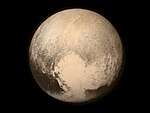K2-3c
K2-3c also known as EPIC 201367065 c is an exoplanet orbiting K2-3 a red dwarf every 24 days. It is 144 ly away.[4] It has a density of 1.82g/cm3, indicating that it could be a Gas dwarf or a mini-Neptune. It is one of the smallest gas planets ever discovered. Despite not being the smallest planet in the system by radius,[5] by mass it is by far the least massive, with a mass only double that of Earth.[5]
| Discovery[1] | |
|---|---|
| Discovery site | Kepler Space Observatory |
| Discovery date | 2015 |
| Transit | |
| Orbital characteristics | |
| 0.1413+0.0044 −0.0047 AU | |
| Eccentricity | 0.04±0.04[2] |
| 24.64638±0.00017[3] d | |
| Inclination | 89.70±0.20[2] |
| Semi-amplitude | 0.95±0.37[3] |
| Star | K2-3 |
| Physical characteristics | |
Mean radius | 1.77±0.18[3] R⊕ |
| Mass | 3.1+1.3 −1.2[3] M⊕ |
Mean density | 3.1+1.9 −1.3 g cm−3 |
| Temperature | 374 K (101 °C; 214 °F) |
References
- Crossfield, Ian J. M.; et al. (2015). "A Nearby M Star with Three Transiting Super-Earths Discovered by K2". The Astrophysical Journal. 804 (1). 10. arXiv:1501.03798. Bibcode:2015ApJ...804...10C. doi:10.1088/0004-637X/804/1/10.
- "K2-3 c CONFIRMED PLANET OVERVIEW PAGE". NASA Exoplanet Archive. Retrieved 2015-10-17.
- Damasso, M.; et al. (2018). "Eyes on K2-3: A system of three likely sub-Neptunes characterized with HARPS-N and HARPS". Astronomy and Astrophysics. 615. A69. arXiv:1802.08320. Bibcode:2018A&A...615A..69D. doi:10.1051/0004-6361/201732459.
- Brown, A. G. A.; et al. (Gaia collaboration) (August 2018). "Gaia Data Release 2: Summary of the contents and survey properties". Astronomy & Astrophysics. 616. A1. arXiv:1804.09365. Bibcode:2018A&A...616A...1G. doi:10.1051/0004-6361/201833051. Gaia DR2 record for this source at VizieR.
- "K2-3 PLANET HOST PAGE". NASA Exoplanet Archive. Retrieved 2015-10-17.
This article is issued from Wikipedia. The text is licensed under Creative Commons - Attribution - Sharealike. Additional terms may apply for the media files.


